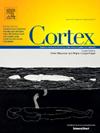健康成人日常认知表现的个体差异性与上纵束白质组织有关
IF 3.3
2区 心理学
Q1 BEHAVIORAL SCIENCES
引用次数: 0
摘要
行为研究传统上侧重于个体之间认知表现的平均差异,通常将个体内部随时间的波动视为测量误差。然而,最近的研究强调,认知本质上是动态的,随着时间的推移表现出高度的个人变异性。这种个体差异性(IIV)被认为是注意力控制和大脑功能的重要标志。注意控制的稳定性是由额顶叶白质束(WM)的组织支持的,如上纵束(SLF)。在本研究中,我们研究了30名健康成人(21-62岁,19名女性)日常认知表现中的IIV与SLF纤维特异性WM特征之间的关系。参与者在30天的时间里进行了弥散性核磁共振扫描,随后进行了工作记忆和处理速度的每日生态瞬间评估(EMA)。使用基于固定的分析(FBA)框架,我们研究了认知表现与SLF的微观结构纤维密度(FD)和宏观结构纤维横截面(FC)之间的关系。我们的研究结果显示,在每个任务中,尤其是在工作记忆任务中,都有很高的iv度。此外,较高的IIV与较低的工作记忆平均表现有关,但与处理速度任务无关。最后,较高的IIV和较低的视觉工作记忆平均表现与WM纤维微观结构和宏观结构的下降有关。我们的研究结果表明,额顶叶通路的WM微观/宏观结构的变化可能在支持认知表现的稳定性中发挥作用,并突出了其作为理解健康和临床人群认知动态的标志的潜力。本文章由计算机程序翻译,如有差异,请以英文原文为准。
Intraindividual variability in daily cognitive performance is associated with white matter organization of the superior longitudinal fasciculus in healthy adults
Behavioural studies have traditionally focused on mean differences in cognitive performance between individuals, often regarding fluctuations within individuals over time as measurement error. However, recent research emphasizes that cognition is inherently dynamic, exhibiting high within-person variability over time. This intraindividual variability (IIV) has been suggested as an important marker of attentional control and brain functioning. Stability of attentional control is supported by the organisation of fronto-parietal white matter (WM) tracts, such as the superior longitudinal fasciculus (SLF). In the present study, we investigate the relationship between IIV in daily cognitive performance and fibre-specific WM characteristics of the SLF in 30 healthy adults (aged 21–62 years, 19 females). Participants underwent a diffusion MRI scan followed by daily ecological momentary assessment (EMA) of working memory and processing speed over a 30-day period. Using the fixel-based analysis (FBA) framework, we investigated the association between IIV in cognitive performance and microstructural fibre density (FD) and macrostructural fibre cross section (FC) of the SLF. Our results revealed a high degree of IIV across each task, particularly for working memory tasks. Moreover, higher IIV was associated with lower average performance for working memory but not processing speed tasks. Finally, higher IIV and lower mean performance for visual working memory were associated with decreased WM fibre microstructure and macrostructure. Our findings indicate that variation in WM micro/macrostructure of a fronto-parietal pathway may play a role in supporting the stability of cognitive performance over time, highlighting its potential as a marker for understanding cognitive dynamics in healthy and clinical populations.
求助全文
通过发布文献求助,成功后即可免费获取论文全文。
去求助
来源期刊

Cortex
医学-行为科学
CiteScore
7.00
自引率
5.60%
发文量
250
审稿时长
74 days
期刊介绍:
CORTEX is an international journal devoted to the study of cognition and of the relationship between the nervous system and mental processes, particularly as these are reflected in the behaviour of patients with acquired brain lesions, normal volunteers, children with typical and atypical development, and in the activation of brain regions and systems as recorded by functional neuroimaging techniques. It was founded in 1964 by Ennio De Renzi.
 求助内容:
求助内容: 应助结果提醒方式:
应助结果提醒方式:


